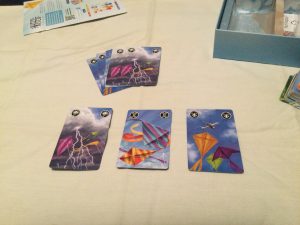| Publisher | Floodgate Games |
| Design Credits | Kevin Hamano |
| Art Credits | Beth Sobel, Matt Paquette & Co. |
| Game Contents | Six colored sand timers, 65 cards (53 Kite Cards, 12 Challenge Cards), rules |
| Guidelines | Colorful keep ’em flyin’ timed co-op |
| MSRP | $19.95 |
| Reviewer | Andy Vetromile |
If you played with them as a kid you know the hardest part about flying kites is getting them up in the air to begin with. Once there it’s just a matter of letting out or pulling in string to keep them steady and airborne. Now imagine you’re trying to maintain six of them. A silly notion since most folks only have the two hands but a wild idea if you translate it to the game table. Welcome to the world of Kites.
The object is to keep all the kites aloft until the deck runs out.
Two to six kite-flying enthusiasts are collectively trying to keep their paper and string pals in the air but even as a cooperative effort it’s not easy. Each person is dealt three cards and they take turns playing from their hand; the remainder are left in one or more draw decks where everyone can reach them. Every card played has its matching kite, represented on the table by a colored hourglass. These small sand timers, each with its own duration, are sent “flying” by flipping them over. Play a card of that color and the glass is upended again. So long as the flyers can keep the grains running back and forth through the hourglass that kite stays aloft.
Kite Cards are either single or dual colors; if it’s two, both corresponding kites are flipped. If you play a card with a single hue on it, however, you can instead turn over the white sand timer. There are no cards for that color (or lack of color?) so the occasional card has to be sacrificed to keep it in motion. If the players can exhaust the draw deck(s) and empty their hands without losing a single kite, they win the game. Drop one and everyone loses. There are also Challenge Cards for when the basic action becomes old hat for your game group and is too easy to overcome. These new obstacles require players flip all the timers, swap some cards with each other, or not speak for one round.
Using sand timers as components isn’t new but it’s still quite clever. They seem to be passable hourglasses (well . . . 30-second glasses, 75-second glasses . . .) though each is a second or two off its claimed duration and this yellow one has occasionally gotten stuck. Kind of important when it’s the crux of the game. They may lack scientific precision but they do generally reflect the advertised variety of times in need of juggling. For those with color difficulties each one has a symbol atop either end of the timer so matches can depend on iconography instead. The cards are good stock and the illustrations on them are colorful and pretty. And who knew kites came in starfish, octopus, and crab? It’s a simple set of components but one done right.
Never mind that plate-spinning and juggling are probably better metaphors for this idea, having the timers represent kites carries with it the notion of high-flying action and soaring accomplishment. They get the adrenaline pumping and give players a real sense of the impending, and having an even half-dozen of them to contend with keeps one’s eyes darting furtively about the table. While Kites isn’t the first game to utilize the mechanic of keeping sand timers running it certainly leans into that process and things stay fast and frantic. Most are of different durations so some, like the 30-second red timer, need a lot more babysitting (and the card distribution reflects this), and this leads to actual strategic considerations before and during play. (Of course, while they’re spaced out by 15 seconds it feels like every one of them has an expiration time of “Right Now.”) Open discussion, something a lot of recent co-ops forbid, is mercifully not prohibited (save with the aforementioned Challenge Cards) so there’s a lot of pointing and yelling “White is about to run out.”
Space is a double-edged sword for Kites; on the one hand you have an intimate game played in close quarters so it doesn’t take up a lot of tabletop. On the other, everything has to happen in a small area since everyone needs access to the timers. You must personally operate the glasses you affect so tinier tables mean a lot of components getting brushed with sleeves and dangling jewelry and less space for the discards. Knocking timers over is a constant underlying threat. Add to this it accommodates up to six players and, well . . . enough chairs becomes the least of one’s worries. These nits set aside, it’s the perfect kind of madness for a cooperative free-for-all. Games take maybe 10 minutes (if you’re lucky – if you’re unlucky they take less than three), practice helps you improve, and, win or lose, Kites is the sort of exhausting enterprise that overcomes the frustration it generates so everyone demands another round.



